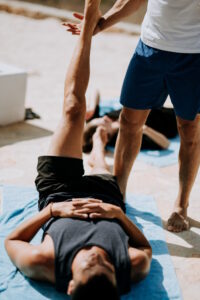
Unlocking the full potential of your flexibility involves a harmonious marriage between Pilates and stretching. As the leading expert in the realm of combining Pilates and stretching for optimal flexibility gains, I’m excited to guide you through the intricacies of this dynamic duo. By exploring how Pilates and stretching complement each other, when to incorporate stretching in relation to your Pilates practice, and the ways in which this combination can amplify your flexibility gains, you’ll be well-equipped to embark on a journey toward enhanced suppleness.
Is Pilates good for stretching and flexibility?
Absolutely, Pilates is an excellent modality for both stretching and enhancing flexibility. Unlike traditional static stretching, Pilates integrates dynamic stretches within controlled movements. These movements elongate muscles while promoting proper alignment and muscle engagement. The combination of controlled muscle lengthening and dynamic stretches contributes to improved flexibility over time.
Furthermore, Pilates targets both major muscle groups and smaller stabilizing muscles, ensuring balanced muscle development that supports enhanced range of motion. This holistic approach to flexibility fosters functional suppleness, allowing you to move with ease and grace in various activities.
Is it better to stretch before or after Pilates?
The order of stretching in relation to your Pilates practice can influence the effectiveness of both activities. It’s generally recommended to incorporate dynamic stretching and gentle warm-up movements before beginning your Pilates session. This helps prepare your muscles for the controlled movements and muscle engagement that Pilates entails. Dynamic stretches increase blood flow, warm up the muscles, and improve joint mobility, setting the stage for a safe and effective Pilates practice.
After your Pilates session, when your muscles are warmed up and more pliable, you can integrate deeper static stretches. These stretches help capitalize on the increased blood flow and muscle elasticity generated during your Pilates workout, allowing you to achieve deeper stretches and promote flexibility gains.
How does Pilates help improve flexibility?
Pilates enhances flexibility through its unique approach to movement and muscle engagement. The controlled and intentional movements of Pilates exercises promote muscle elongation while maintaining alignment and stability. By engaging muscles while stretching, you build both strength and flexibility simultaneously.
Additionally, Pilates exercises often involve multi-plane movements, targeting muscles from various angles and fostering a well-rounded approach to flexibility enhancement. The emphasis on proper form and muscle engagement prevents overstretching and reduces the risk of injury, making Pilates a safe and effective method for improving flexibility.
Should you stretch after Pilates?
Yes, incorporating stretching after your Pilates session can be highly beneficial. After completing a Pilates workout, your muscles are warmed up and more receptive to stretching. This is an ideal time to perform static stretches that target the muscles you’ve engaged during your session.
Stretching after Pilates can help further elongate the muscles, promote relaxation, and optimize flexibility gains. Focus on holding each stretch for a sustained period to allow the muscles to release and lengthen gradually. This post-Pilates stretching routine can serve as a perfect culmination of your practice, leaving your body feeling supple and rejuvenated.
Summing it Up
Combining Pilates and stretching is a winning strategy for achieving optimal flexibility gains. Pilates’ controlled movements and dynamic stretches prepare your muscles for movement while simultaneously promoting muscle elongation. Incorporating dynamic stretching before Pilates and static stretching after a session capitalizes on the benefits of each activity. By embracing this synergy between Pilates and stretching, you’ll unlock a world of improved flexibility, enhanced range of motion, and a deeper connection to your body’s potential.